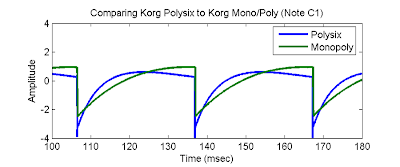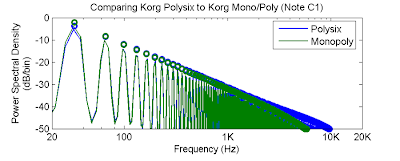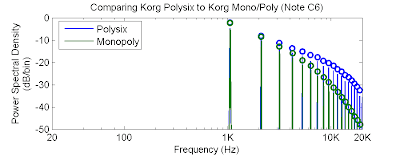As you know, I have both a Korg Mono/Poly and a Korg Polysix. I've had the Mono/Poly for longer and my visceral response to its sound is what motivated my purchase of the Polysix. Being from the same vintage, and having many of the same components (like the SSM filter chip), made me assume that they would sound as similar as two analog synths could. Well, once I'm got the Polysix home, I found that it didn't sound the same as the Mono/Poly. In some ways the Polysix was better and in some ways the Mono/Poly was better.
![]() |
| Recording Tones from my Korg Polysix (Left) for Comparison to my Korg Mono/Poly (Right) |
Specifically, I felt that the Mono/Poly had better bass and that the Mono/Poly had a much more engaging (less harsh, more smooth) lead sound in the upper octaves. The Polysix, on the other hand, had a bit more sizzle and, on chords, the upper mids / low treble felt more liquid and present. Being a bit geeky, I immediately wondered if I could measure and quantify the difference. If I could quantify it, then maybe I could understand it, which means that maybe I could control and command it at will. And, therein, lies the power of synth hacking.
OK, let's do some recordings, analyze them, and see what we can find...
For recordings, I simply plugged the output of the Polysix into my trusty portable audio recorder (M-Audio Microtrak II, shown in pictures above). I recorded raw WAV files at 44.1 kHz at 16 bits. I recorded 4 seconds of C1, then four seconds of C2, and so on up through all the octaves. The synth was configured to play one voice, it was set to sawtooth, and the filter was wide open with no resonance. I repeated the same process for the Mono/Poly (again, just one voice). I brought all the files into Matlab for some plotting and analysis. Below is plot comparing the raw time-domain audio of a sawtooth waveform at the lowest note, C1.
![]() |
| Polysix and Mono/Poly when playing a sawtooth waveform down at C1. |
Clearly, there is a difference in the shape of these two waveforms. To those used to looking at oscilloscope traces, this plot will be familiar. You'll note that neither plot is as much like a sawtooth as one might like -- in both cases, the "ramp" portion of the sawtooth is not as straight as one might expect. This is due to some roll-off in the bass frequencies in the output. The Polysix waveform (blue) is more rounded than the Mono/Poly (green), so it appears to have a little less bass. As for high frequencies, note that the Polysix (blue) has a very sharp downward spike at each vertical transition in the sawtooth. It actually appears to overshoot. This kind of sharp, narrow spike requires very high frequency response, which suggests that the Polysix does indeed have more "sizzle" than the Mono/Poly.
Now that we've seen some interesting features, let's try to quantify them. I've chosen to take the FFT of each recording in order to assess the frequency content of each note. After a bit of normalization to equalize the volume of each recording, I would get plots like the one below. Note that frequency is now on the horizontal axis instead of time.
![]() |
| Spectrum recorded from the Polysix and the Mono/Poly when playing the lowest C ("C1"). |
The first thing to notice is that the spectrum of the note is composed of a large number of "spikes" in the frequency domain. This is what one should expect for a sawtooth wave. If I had used a sine wave instead of a sawtooth, I would have just gotten one spike...the one at the fundamental pitch. What differentiates a sine wave from a sawtooth wave from a square wave is the number of harmonics and their relative magnitude. Therefore, this plot is very normal.
Looking now at the Polysix spectrum (blue) compared to the Mono/Poly spectrum green), we see that they are largely similar until we get to the highest frequencies. Above ~3 kHz, we see that the Polysix has stronger high frequencies than the Mono/Poly. This could be part of the difference in "sizzle" that I'm hearing. Let's dig in a little deeper.
The plot above is confusing because it shows the signal energy at important frequencies (the fundamental and all the harmonics) and at unimportant frequencies (everything between the harmonics). Let's extract just the energy at the fundamental and at each harmonic and plot just those values. The resulting plot (below) is much simpler and easier to see what's going on. For reference, I even include a line that shows the spectrum for the ideal sawtooth waveform. You'll see that both the Polysix (blue) and Mono/Poly (green) have pretty good sawtooths. Only above ~3 kHz do they begin to diverge in any significant way.
![]() |
| Spectrum Assessed at Just the Fundamental and Harmonic Frequencies. |
Let's further simplify this plot by taking the difference of each spectrum relative to the ideal sawtooth spectrum. The result is shown below. Now we're getting somewhere.
![]() |
| Spectrum Compared to the Spectrum of an Ideal Sawtooth Waveform |
First, look at the left-most side of the graph. Here are the low frequencies. The fundamental at C1 is abut 33 Hz. That's where this graph starts. Note that it shows that the Polysix (blue) is a little below the Mono/Poly (green). At this very low frequency, the Polysix is showing 1.6 dB less bass than the Mono/Poly. That's not much of a difference. So, maybe my subjective assessment that the Mono/Poly has more bass than the Polysix is supported by this data, or maybe not. Lots of other factors can affect the psychoacoustics of bass perception besides just the literal amount of bass in the air. So, I'm going to refrain on making any conclusions about bass.
Looking at the right-most side of the graph, we see huge differences in the treble response. Unlike the assessment of bass, this difference in treble is very clear. Comparing the Polysix (blue) to the Mono/Poly (green) we see a 3 dB difference by 4 kHz. That's definitely audible. By the time you get out to 10 kHz, we've got a 10 dB difference. That's a big difference in "sizzle". This definitely confirms what I was hearing. This doesn't tell us *why* they're different, but it's an objective measure that we can now use to probe within each synth to find where the difference occurs. That's an exercise for later.
Another behavior that catches my eye in the figure above is that the Polysix diverges from the ideal sawtooth by first going *up* before going down. It's as if there is a treble knob within the synth and that it is turned up a bit in the 3 kHz to 10 kHz region. The peak response is at 6.8 kHz and is 2.2 dB above the ideal sawtooth. What's the cause of this apparent enhancement of the treble? Well, I'm not sure, but to my eye, it appears that the resonance of the VCF on the Polysix might be a bit active, even though I turned it down to "zero". I'll have to open her up and check it out at a later time.
The more important question is whether this boost in treble is the cause of the "upper mids / low treble feel more liquid and present" perception that I mentioned earlier. Maybe. If I'm able to tune the boost out of the system (through adjustments to the resonance or whatever), we'll see if the "liquid and present" feel goes away. Given that I like the "liquid and present" feel, I might choose to keep it the way that it is.
A downside of this enhanced upper-mids is reflected in my original comment that I preferred the sound of the Mono/Poly for lead work in the upper octaves. I felt that it was more engaging and less harsh. Excessive upper-mids could be the source of "harshness". When I examine the data for a high note (C6) many of the conclusions drawn from the graphs above still hold for C6...
For example, below, the time domain plot shows that the Polysix still has its over-shooting downward spike suggested lots of high-treble.
![]() |
| Time-Domain Plot of Raw Waveform of High Note, C6 |
The FFT output comparing the two C6 notes shows that the Polysix definitely has more more treble.
![]() |
| Frequency-Domain Plot of High Note, C6 |
And, comparison of the amplitude of the fundamental and harmonics to the ideal sawtooth waveform (below) shows the same high-frequency roll-off in the Mono/Poly and the same slight high-frequency boost in the Polysix.
![]() |
| Comparison of Harmonic Content of High Notes (C6) to Ideal Sawtooth |
So, while "harshness" is also a complicated psychoacoustic phenomenon, these plots confirm that there is a substantial difference in the amount of treble above 3 kHz between the Polysix and the Monopoly. This is true for both low notes (the C1 analyzed first) and for high notes (the C6 analyzed second). In my opinion, this extra treble is at least one of the factors of the apparent harshness (for lead work) of the Polysix compared to the Mono/Poly.
Edit: Follow-up on the Polysix is
here.
Edit: Follow-up on the Mono/Poly is
here.







